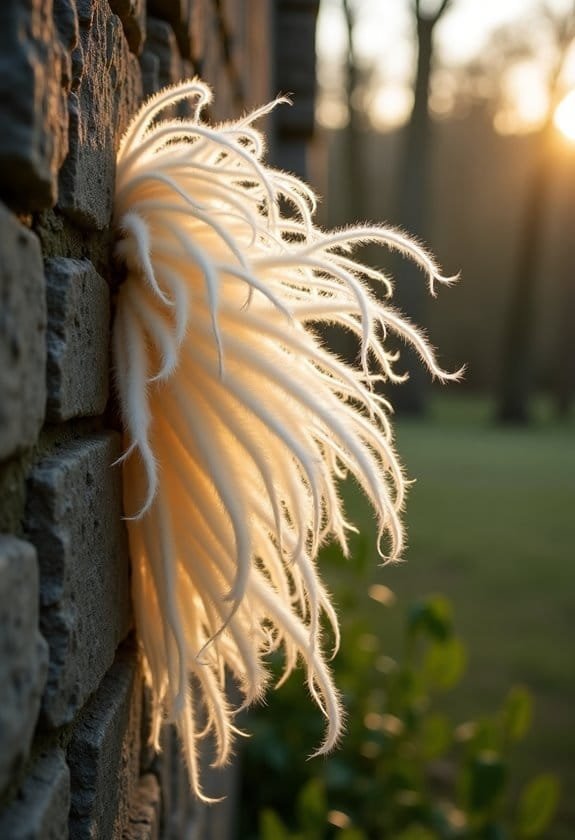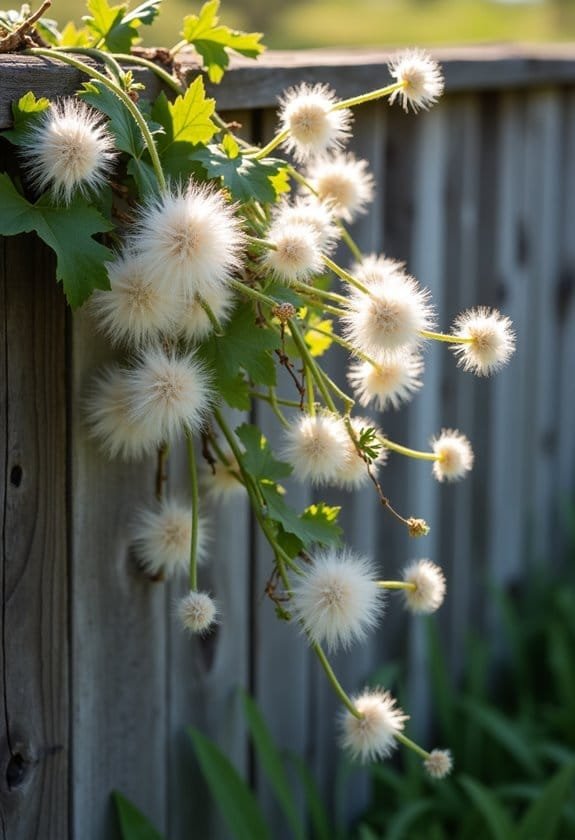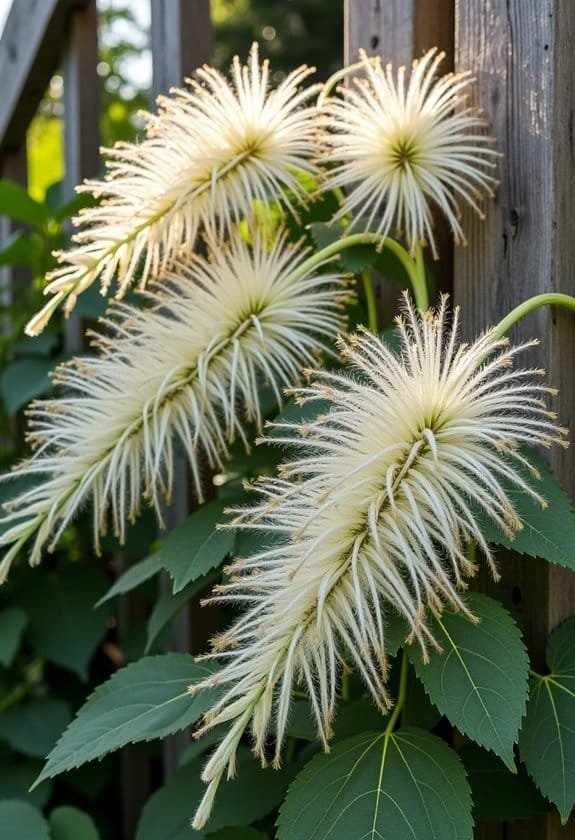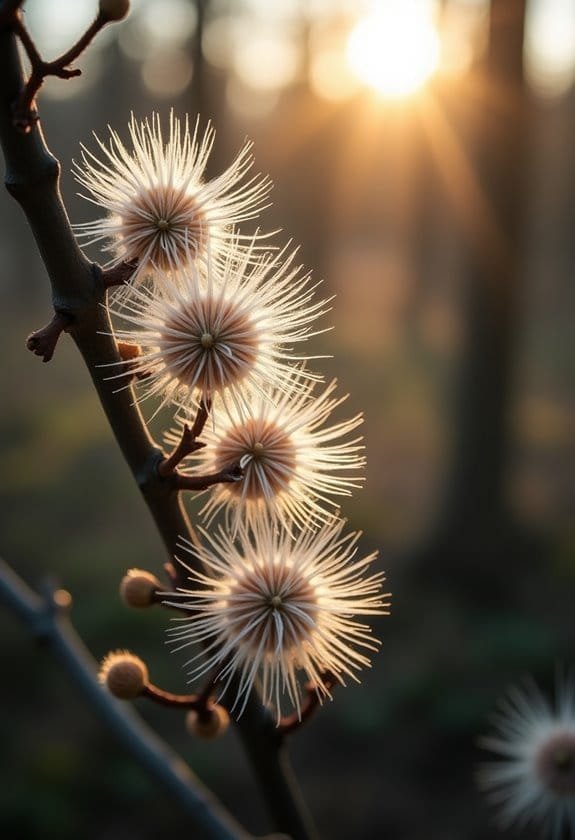Old Man's Beard (Clematis essentialis) is a vigorous climbing shrub that can reach lengths of 90 feet, distinguished by its silvery-white seed heads resembling flowing beards. This member of the Ranunculaceae family produces compound leaves with 3-5 elliptical leaflets and features grooved stems that enable its impressive climbing ability. While it's prized for its creamy-white flowers that attract pollinators from June to September, it's also notorious for its invasive nature, producing over 100,000 seeds annually. Its rapid growth and dense canopy formation make it both a fascinating botanical specimen and a significant ecological concern that warrants careful consideration.
Main Points
- Clematis vitalba is a vigorous climbing shrub that grows up to 90 feet long, known for its distinctive silvery-white seed heads.
- It belongs to the Ranunculaceae family and features compound leaves with 3-5 leaflets and grooved stems.
- The plant produces over 100,000 seeds annually and can regenerate from broken stems, making it highly invasive in many regions.
- Its creamy-white flowers bloom from June to September, attracting pollinators like bees and hoverflies.
- Native to Eurasia and North Africa, it thrives in alkaline soils and can overwhelm native vegetation by forming dense canopies.
Introduction

Old Man's Beard (Clematis essentialis) stands out as a remarkable climbing shrub that has captured attention through its distinctive appearance and vigorous growth patterns.
The plant earned its common name from the striking, silvery-white seed heads that transform the vine into a cascade of silky, beard-like plumes during autumn.
This perennial climber, which can extend up to 90 feet in length, features grooved stems and compound leaves, making it both a fascinating botanical specimen and a potentially challenging ecological presence in various landscapes.
Common Name
The distinctive appearance of Clematis essentialis has led to its widely recognized common name "Old Man's Beard," which refers to the plant's fluffy white seed heads that resemble a flowing elderly beard.
These characteristic seed heads, with their silky, thread-like appendages, create a striking visual effect that's particularly noticeable during the plant's reproductive phase.
The species is also commonly known as "Traveller's Joy," a name that reflects its historical presence along countryside paths and its contribution to rural landscapes.
This alternative designation emerged from the plant's tendency to drape itself over hedgerows and trees, creating picturesque scenes that traditionally delighted travelers on their journeys.
The dual nomenclature offers insight into both the plant's physical characteristics and its cultural significance in rural settings.
While "Old Man's Beard" emphasizes its distinctive morphological features, "Traveller's Joy" captures its aesthetic appeal and historical connection to human movement through landscapes.
These common names have persisted through generations, despite the plant's later recognition as an invasive species capable of overwhelming native vegetation in many regions.
Scientific Name
Botanically classified as Clematis essentialis, Old Man's Beard belongs to the buttercup family Ranunculaceae. The scientific nomenclature reveals fascinating insights into the plant's characteristics and behavior, with each component of its name carrying specific meaning and historical significance.
The genus name "Clematis" draws its origins from ancient Greek, where it literally translates to "climbing plant," perfectly describing this vigorous vine's natural growth habit. This climbing perennial can achieve remarkable lengths of up to 30 meters, demonstrating the accuracy of its classical naming.
The species epithet "essentialis" combines two Latin words: "vita" meaning life, and "alba" referring to white, reflecting both its robust essence and pale appearance.
This scientific classification places the plant firmly within the context of its native range across Eurasia and North Africa, where it thrives in calcium-rich, alkaline soils. The formal botanical name helps researchers and horticulturists precisely identify and study this species, distinguishing it from the approximately 300 other members of the Clematis genus worldwide.
Overview
Throughout Europe and parts of North Africa, Old Man's Beard stands as one of nature's most tenacious climbers, distinguished by its grooved stems and delicate compound leaves. This remarkable perennial shrub, scientifically classified as Clematis essentialis, showcases its adaptability across diverse landscapes, particularly flourishing in the British Isles from southern England to Wales.
From June through September, the plant transforms its appearance with clusters of subtle greenish-white blooms, which later give way to its namesake feature – ethereal, silvery seed heads resembling wispy facial hair.
While the old man's beard presents an enchanting sight in gardens, its vigorous growth habit and extraordinary reproductive capacity pose significant ecological challenges. A single plant can produce an overwhelming 100,000 seeds, while its ability to regenerate from broken stems and roots further amplifies its invasive potential.
This remarkable colonizing ability enables it to form dense, sweeping canopies that can overwhelm native vegetation, fundamentally altering local ecosystem dynamics and threatening biodiversity in affected areas.
Key Features
Old Man's Beard stands out as a remarkable climbing shrub, reaching impressive lengths of up to 90 feet with its distinctive grooved stems and compound leaves.
The plant's foliage consists of 3-5 elliptical leaflets arranged in opposite pairs, featuring rough-toothed margins that contribute to its characteristic appearance.
Its delicate cream-colored flowers emerge in loose clusters from June through September, creating an eye-catching display that transforms into feathery seed heads, which give the plant its common name.
Growth Size
Along with its distinctive appearance, Clematis essentialis stands out for its impressive growth potential, reaching lengths of up to 90 feet. This remarkable climbing shrub, commonly known as Old Man's Beard or traveler's joy, demonstrates extraordinary vertical expansion capabilities through its vigorous growth patterns.
The plant's extensive growth is supported by its branched and distinctively grooved stems, which provide structural stability as it climbs and spreads across vast surfaces. Its robust nature is further enhanced by its prolific seed production, with a single specimen capable of generating more than 100,000 seeds annually.
During its active growing season from June through September, the plant exhibits remarkable vertical and horizontal expansion, creating dense coverage wherever it establishes itself. The combination of its rapid growth rate and extensive seed dispersal makes it particularly successful at colonizing new areas.
Its deciduous leaves, arranged in opposite pairs with 3-5 elliptical leaflets, contribute to its impressive biomass, while the abundant cream-colored flower clusters further emphasize its substantial presence in the landscape.
Appearance
The distinctive appearance of Old Man's Beard stems from its compound leaves and delicate white flowers that transform into striking seed clusters. This vigorous climber displays compound leaves featuring 3-5 elliptical leaflets with rough-toothed margins arranged in an opposite pattern along its extensive stems.
The Clematis vitalba's blooms emerge as clusters of small white flowers, each measuring approximately 2 centimeters in width, creating a mesmerizing display from June through September. What appears to be petals are actually sepals, adding to the plant's botanical intrigue.
The most remarkable transformation occurs after flowering, when the plant produces its characteristic fluffy, white-grey seed clusters, which earned it its whimsical common name.
The plant's stems are particularly significant, extending up to 30 yards in length and featuring distinctive branched, grooved structures that are readily apparent to the touch. These robust stems enable the plant to climb and spread extensively over surrounding vegetation and structures, creating a cascading effect that dramatically alters the landscape's appearance.
Flowering Season
During the height of summer, Clematis essentialis bursts into bloom with delicate cream-colored flowers that persist from June through September. These distinctive blossoms, measuring approximately 2 centimeters in width, cluster together in loose arrangements that create an ethereal display against the plant's climbing tendrils.
The flowers are small but remarkable in their structure, featuring four prominent modified sepals that many observers mistake for petals. Their simple yet elegant appearance serves an important purpose in attracting various pollinators, particularly bees and hoverflies, which guarantee the plant's successful reproduction during the warm season.
As summer shifts into autumn, these delicate blooms undergo a fascinating transformation. The flowers gradually develop into their characteristic seed heads, which showcase the plant's most memorable feature – the silvery, feathered appendages that inspired its common name, Old Man's Beard.
This progression from flower to seed head marks a significant phase in the plant's annual cycle, creating a striking visual display that enhances the landscape well beyond the initial flowering period.
Growing Requirements

Old Man's Beard flourishes in full sunlight and thrives in alkaline soils that maintain consistent moisture while offering excellent drainage.
The climbing plant adapts remarkably well to various soil compositions, from rich garden loam to more challenging substrates, as long as the pH remains above neutral.
For best growth, this vigorous climber requires temperatures typical of temperate zones, with warm summers providing ideal conditions for its characteristic June-to-September flowering period.
Light
Growing in diverse light conditions, Old Man's Beard demonstrates remarkable adaptability from full sun to partial shade environments. This versatile climbing shrub has evolved to thrive across various light exposures, though it exhibits ideal performance in locations that receive substantial direct sunlight.
For maximum importance and flowering potential, Old Man's Beard requires a minimum of six hours of direct sunlight daily. When provided with abundant light, the plant displays vigorous growth patterns, producing copious flowers and seeds that contribute to its widespread colonization success.
In contrast, insufficient light exposure can result in compromised growth characteristics, as the plant develops elongated, spindly stems in its natural response to seek available light sources.
The plant's climbing nature plays a significant role in its relationship with light, as it frequently ascends surrounding structures or vegetation to reach ideal light conditions. This growth strategy allows Old Man's Beard to position its foliage and flowering stems advantageously, maximizing photosynthetic efficiency while maintaining structural support through its host plants or artificial structures.
Soil
Soil composition plays an essential role in the success of Old Man's Beard, with the plant showing a marked preference for base-rich alkaline environments.
Like a master architect building on a solid foundation, this climbing shrub establishes itself most effectively in well-drained soils that maintain consistent moisture levels throughout the growing season.
The plant's adaptability to various soil conditions makes it a versatile species, though it demonstrates particular vigor in disturbed areas where competition from other plants is minimal.
In these environments, its root system can efficiently extract nutrients and moisture from the soil, supporting its rapid growth and spread.
The combination of warm summers and consistently damp soil creates favorable growing conditions, allowing the plant to flourish like a natural tapestry across its chosen terrain.
When cultivating or managing Old Man's Beard, gardeners must pay careful attention to soil pH and moisture retention.
These factors greatly influence the plant's establishment and long-term success, making proper soil assessment and preparation vital steps in both horticultural and control applications.
Water
While many climbing plants can survive periods of drought, consistent moisture proves vital for Old Man's Beard to reach its full potential. This resilient climber requires regular watering, particularly during its establishment phase, to develop a robust root system and maintain vigorous growth throughout the growing season.
In regions where natural rainfall may be insufficient, supplemental irrigation becomes essential for the plant's success. Local water conservation districts often recommend implementing moisture-retention strategies, such as applying a 2-3 inch layer of organic mulch around the base of the plant. This practice considerably reduces water evaporation and helps maintain the consistent soil moisture that Old Man's Beard craves.
During extended dry periods, deep watering sessions performed once or twice weekly prove more beneficial than frequent shallow irrigation, as this encourages deeper root development. The soil should remain consistently damp but never waterlogged, as excessive moisture can lead to root rot.
Monitoring soil moisture levels regularly, especially during summer months, guarantees the plant receives adequate hydration while preventing both under and over-watering issues that could compromise its health.
Temperature
Temperature plays a crucial role in the successful cultivation of Old Man's Beard, with ideal growth occurring between 15°C to 25°C (59°F to 77°F). These moderate temperatures create favorable conditions for the plant's metabolic processes, supporting vigorous growth and development throughout the growing season.
The plant's remarkable adaptability to varying temperature ranges makes it a resilient choice for temperate regions, where it flourishes in climates characterized by warm summers. During the primary growing period from spring through late summer, consistent warmth encourages robust vine development and abundant flowering.
The plant's temperature preferences align perfectly with its natural habitat requirements, where it can establish itself as a dominant climbing shrub in suitable conditions.
While Old Man's Beard demonstrates considerable tolerance to temperature fluctuations, maintaining temperatures within the favorable range guarantees the most successful growth outcomes. This temperature sweet spot, combined with the plant's preference for base-rich alkaline soils and adequate moisture, creates ideal conditions for this vigorous climber to thrive and establish itself as a striking presence in gardens and natural landscapes.
Pollinator Criteria
Old Man's Beard plays an essential role in supporting pollinator populations through its abundant creamy-white flowers that bloom from July to September.
The plant's clustered blossoms, measuring 2 cm in width, attract diverse pollinators including bees and hoverflies that seek out its rich nectar and pollen resources.
These beneficial insects frequently visit the flowering vines during peak summer months, contributing to both the plant's reproduction and the broader ecosystem's pollination networks.
Attracted Pollinators
During summer months, the white fragrant flowers of Clematis essentialis serve as powerful attractants for various pollinators, particularly bees and hoverflies. These industrious insects are drawn to the plant's abundant nectar production, which provides them with crucial sustenance throughout the extended blooming period from June to September.
The plant's impressive flower count creates a veritable buffet for pollinating species, with each stem producing numerous blossoms that enhance the likelihood of successful pollinator visits. This mutually beneficial relationship supports both the plant's reproduction and the sustenance of local pollinator populations, contributing considerably to the ecosystem's biodiversity.
The interaction between Old Man's Beard and its pollinators demonstrates nature's intricate balance, as the insects' foraging activities facilitate the plant's remarkable seed production capabilities, resulting in over 100,000 seeds annually.
While this reproductive success has contributed to the species' invasive tendencies, it also highlights the effectiveness of its pollination strategy, which relies on the consistent presence of these essential insect visitors throughout the summer season.
Pollination Method
The pollination success of Clematis essentialis relies on four key criteria that align perfectly with its primary pollinators. The plant's strategic flowering period, which spans from June through September, coincides with peak activity periods of bees and hoverflies, ensuring ideal pollination opportunities.
The flower's architecture plays an essential role in its pollination mechanism, featuring four distinctive petal-like sepals that create an easily navigable landing platform for visiting insects. These specialized structures, combined with the plant's abundant nectar production, guide pollinators directly to the reproductive components, maximizing the efficiency of pollen transfer during each visit.
The dense clustering of Old Man's Beard's creamy-white blooms serves a dual purpose in the pollination process, creating both a visible beacon for attracted insects and a concentrated feeding station that encourages extended foraging sessions.
This strategic arrangement greatly enhances cross-pollination rates, leading to remarkable reproductive success evidenced by the plant's capacity to produce over 100,000 seeds per individual specimen, ensuring its continued proliferation throughout its native range.
Care & Maintenance

Successful care of Old Man's Beard starts with strategic planting in well-draining soil and regular monitoring to prevent its invasive spread into unwanted areas.
While the vine thrives alongside sturdy structures and complementary plants like climbing roses or wisteria, gardeners must maintain vigilant control through early spring pruning and prompt removal of wayward seedlings.
Effective maintenance includes implementing barriers such as landscape fabric around desired plantings, disposing of trimmed material in sealed bags, and establishing clear boundaries to protect neighboring vegetation from being overwhelmed.
Planting Tips
Growing Old Man's Beard starts with selecting the right location and timing your planting carefully. The vine thrives in well-drained, consistently damp soil conditions, preferring sites that receive full sun to partial shade throughout the day for ideal development.
The most successful planting occurs during spring or fall, when moderate temperatures and increased soil moisture create favorable conditions for root establishment. Before introducing the plant, it's important to thoroughly prepare the site by eliminating any competing vegetation and clearing away debris that might impede growth.
Once planted, maintaining consistent soil moisture is paramount, particularly during the initial establishment phase when the root system is developing.
To enhance growing conditions and protect the plant's root zone, apply a 2-3 inch layer of organic mulch around the base, extending it outward to cover the entire root area. This protective barrier serves multiple purposes: it helps retain essential soil moisture, suppresses unwanted weed growth, and provides insulation against temperature fluctuations that could stress the developing root system.
Ongoing Care
Maintaining Old Man's Beard requires vigilant monitoring and regular intervention to prevent uncontrolled spread. Regular inspections during spring and fall, when the traveler's joy is most active, allow gardeners to identify and address new growth before it becomes problematic.
For effective ongoing care of this small beard variety, cutting back established vines at chest height proves most successful when the soil retains moisture. After removal, placing the cut material on a tarp allows it to thoroughly desiccate, preventing any chance of re-establishment through accidental dispersal.
Implementing a robust mulching strategy around cleared areas serves dual purposes: suppressing unwanted seedlings and maintaining ideal soil moisture levels.
Community involvement plays an essential role in managing this vigorous climber. Educational initiatives help neighbors understand the ecological implications of unchecked growth and encourage collaborative management efforts.
Suggested Companions
Several well-chosen companion plants can thrive alongside Old Man's Beard while helping to manage its vigorous growth habits. Honeysuckle and native climbing species make excellent companions, as they possess the robust nature needed to compete with Old Man's Beard's assertive spreading tendencies.
When selecting companion plants, it's crucial to take into account species that flourish in similar growing conditions. Ferns and specific wildflowers that prefer well-drained, moisture-retentive soil create a harmonious planting arrangement, while stronger plants and established trees can provide the structural support necessary for Old Man's Beard's climbing nature.
Regular maintenance, including strategic pruning, guarantees these companions receive adequate light and space to develop properly.
Creating a diverse plant community around Old Man's Beard serves multiple purposes within the garden ecosystem. The integration of various companion species not only helps control its potentially invasive characteristics but also establishes valuable wildlife corridors.
These thoughtfully chosen combinations attract beneficial insects and pollinators, fostering a more balanced and sustainable garden environment while simultaneously managing the vigorous growth patterns of this distinctive climber.
How Does Common Tufted Vetch Compare to Old Man’s Beard in Habitat and Growth Patterns?
Common tufted vetch thrives in grasslands, roadsides, and open fields, showcasing dense clusters of purple flowers. Old Man’s Beard, a climbing clematis, prefers woodlands and hedges with its feathery seed heads. For enthusiasts, seeking common tufted vetch plant identification tips can be essential, given its vining habit and preference for nutrient-rich soils.
Common Issues
While Old Man's Beard exhibits remarkable resilience in natural settings, it's susceptible to several fungal infections, including powdery mildew and leaf spot disease, which manifest as discolored patches on its foliage.
Gardeners can combat these issues through improved air circulation, selective pruning of affected areas, and the application of appropriate fungicides when necessary.
The plant's vigorous growth also attracts various insect pests like spider mites and aphids, which can be managed through regular inspection and targeted biological controls rather than broad-spectrum pesticides.
Pests/Diseases
Despite its hardy nature, Old Man's Beard can face several health challenges that gardeners should monitor. Among the most noteworthy pests and diseases affecting this climbing vine, clematis wilt stands out as a particularly troublesome fungal infection caused by Ascochyta clematidina, which can trigger sudden stem dieback and wilting throughout the plant.
While aphids occasionally colonize the plant's tender growth, they typically don't cause extensive damage, though they can lead to distorted leaves and reduced vigor if left unchecked.
In humid conditions, powdery mildew emerges as a common adversary, manifesting as a white, powder-like coating on the foliage that can impair the plant's ability to photosynthesize effectively.
The plant's root system isn't immune to challenges either, as poorly drained soils can foster root rot, resulting in yellowing foliage and stunted growth patterns.
However, these issues needn't spell disaster for Old Man's Beard, as regular monitoring and proper maintenance practices, including ensuring adequate air circulation and well-draining soil conditions, can greatly reduce the risk of serious pest and disease problems.
Solutions
Successful management of Old Man's Beard requires a systematic approach focused on proper timing and extensive removal techniques. The most effective control periods align with spring and autumn months when soil moisture levels facilitate complete root extraction, considerably improving the chances of successful eradication.
To properly address an Old Man's Beard infestation, practitioners should implement a thorough removal strategy that begins with cutting vines at chest height, approximately 1.5 meters from the ground. This technique allows the upper portions to naturally die off while protecting the host tree from unnecessary damage.
Following removal, all extracted plant materials should be carefully placed on tarps to desiccate, preventing any chance of regeneration. Proper disposal is essential for long-term control success. Rather than composting, which can lead to inadvertent spread, all Old Man's Beard materials should be secured in sealed plastic bags for disposal.
Post-removal monitoring becomes vital, as even small remnants can regenerate into full infestations. Regular inspections of previously affected areas should continue for at least two growing seasons to guarantee complete elimination.
Summary

Old Man's Beard stands out as a highly aggressive perennial vine that poses significant ecological challenges wherever it grows. This remarkable climber, capable of reaching lengths up to 90 feet, demonstrates its invasive potential through prolific seed production and rapid vegetative spread throughout various habitats.
The plant's devastating impact on native ecosystems becomes evident as it forms dense, light-blocking canopies over existing vegetation, effectively suppressing the growth and regeneration of indigenous species. Its ability to produce more than 100,000 seeds annually, combined with its capacity for regeneration through stem fragments, makes Old Man's Beard particularly challenging to control in both urban and natural landscapes.
While management strategies exist, including careful timing of removal efforts and proper disposal protocols, the vine's persistent nature requires vigilant monitoring and sustained control efforts.
Its adaptability to different soil conditions and preference for well-drained, damp environments has enabled its successful establishment along forest margins, disturbed areas, and transportation corridors, making it a significant threat to biodiversity conservation efforts worldwide.


